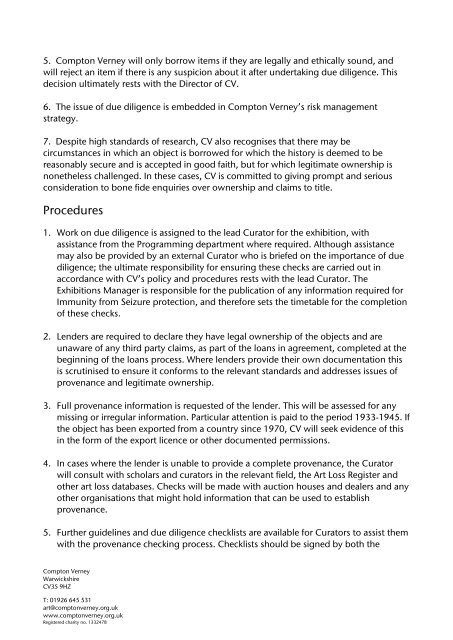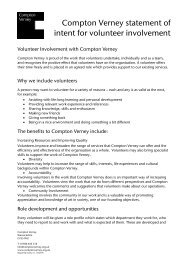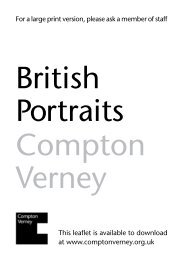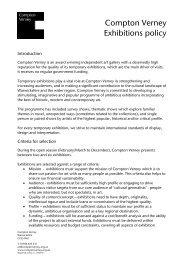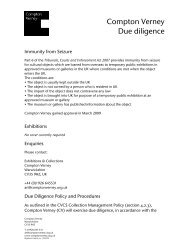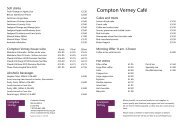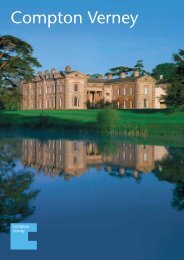Download Compton Verney's Due Diligence Policy and Procedures
Download Compton Verney's Due Diligence Policy and Procedures
Download Compton Verney's Due Diligence Policy and Procedures
You also want an ePaper? Increase the reach of your titles
YUMPU automatically turns print PDFs into web optimized ePapers that Google loves.
5. <strong>Compton</strong> Verney will only borrow items if they are legally <strong>and</strong> ethically sound, <strong>and</strong><br />
will reject an item if there is any suspicion about it after undertaking due diligence. This<br />
decision ultimately rests with the Director of CV.<br />
6. The issue of due diligence is embedded in <strong>Compton</strong> Verney’s risk management<br />
strategy.<br />
7. Despite high st<strong>and</strong>ards of research, CV also recognises that there may be<br />
circumstances in which an object is borrowed for which the history is deemed to be<br />
reasonably secure <strong>and</strong> is accepted in good faith, but for which legitimate ownership is<br />
nonetheless challenged. In these cases, CV is committed to giving prompt <strong>and</strong> serious<br />
consideration to bone fide enquiries over ownership <strong>and</strong> claims to title.<br />
<strong>Procedures</strong><br />
1. Work on due diligence is assigned to the lead Curator for the exhibition, with<br />
assistance from the Programming department where required. Although assistance<br />
may also be provided by an external Curator who is briefed on the importance of due<br />
diligence; the ultimate responsibility for ensuring these checks are carried out in<br />
accordance with CV’s policy <strong>and</strong> procedures rests with the lead Curator. The<br />
Exhibitions Manager is responsible for the publication of any information required for<br />
Immunity from Seizure protection, <strong>and</strong> therefore sets the timetable for the completion<br />
of these checks.<br />
2. Lenders are required to declare they have legal ownership of the objects <strong>and</strong> are<br />
unaware of any third party claims, as part of the loans in agreement, completed at the<br />
beginning of the loans process. Where lenders provide their own documentation this<br />
is scrutinised to ensure it conforms to the relevant st<strong>and</strong>ards <strong>and</strong> addresses issues of<br />
provenance <strong>and</strong> legitimate ownership.<br />
3. Full provenance information is requested of the lender. This will be assessed for any<br />
missing or irregular information. Particular attention is paid to the period 1933-1945. If<br />
the object has been exported from a country since 1970, CV will seek evidence of this<br />
in the form of the export licence or other documented permissions.<br />
4. In cases where the lender is unable to provide a complete provenance, the Curator<br />
will consult with scholars <strong>and</strong> curators in the relevant field, the Art Loss Register <strong>and</strong><br />
other art loss databases. Checks will be made with auction houses <strong>and</strong> dealers <strong>and</strong> any<br />
other organisations that might hold information that can be used to establish<br />
provenance.<br />
5. Further guidelines <strong>and</strong> due diligence checklists are available for Curators to assist them<br />
with the provenance checking process. Checklists should be signed by both the<br />
<strong>Compton</strong> Verney<br />
Warwickshire<br />
CV35 9HZ<br />
T: 01926 645 531<br />
art@comptonverney.org.uk<br />
www.comptonverney.org.uk<br />
Registered charity no. 1332478


